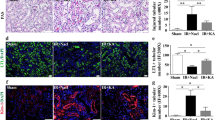Abstract
Background
Signaling pathways induced by the activation of renal toll-like receptor 4 (TLR4) play a pivotal role in chronic kidney disease (CKD). Some recent studies suggested that clarithromycin (CAM), a 14-membered ring macrolide, exerts renoprotective effects by suppressing proinflammatory chemokines. However, its beneficial effects on signaling pathways through renal TLR4 activation are unknown.
Methods
Cultured human mesangial cells (MCs) were treated with lipopolysaccharide (LPS). Expression of monocyte chemoattractant protein-1 (MCP-1/CCL2) and interleukin-8 (IL-8/CXCL8) was analyzed by quantitative RT-PCR and enzyme-linked immunosorbent assay. Signaling pathways affected by CAM were determined by examining the activation of nuclear factor-κB (NF-κB) and p38 mitogen-activated protein kinase (MAPK) by performing western blotting.
Results
CAM inhibited both the mRNA and protein expression of MCP-1 without cell injury but did not affect those expressions of IL-8 in LPS-stimulated MCs. Interestingly, CAM decreased p38 MAPK activation by inhibiting phosphorylation but did not affect NF-κB activation.
Conclusion
Our results indicated that CAM exerted renoprotective effects by suppression of p38 MAPK activity and by decreasing the expression of MCP-1 in LPS-stimulated MCs. Given the implication of TLR4 signaling in CKD, CAM may be a potential treatment of choice for CKD.





Similar content being viewed by others
References
Robson MG. Toll-like receptors and renal disease. Nephron Exp Nephrol. 2009;113:e1–7.
Coppo R, Amore A, Peruzzi L, Vergano L, Camilla R. Innate immunity and IgA nephropathy. J Nephrol. 2010;23:626–32.
Lepenies J, Eardley KS, Kienitz T, Hewison M, Ihl T, Stewart PM, Cockwell P, Quinkler M. Renal TLR4 mRNA expression correlates with inflammatory marker MCP-1 and profibrotic molecule TGF-β1, in patients with chronic kidney disease. Nephron Clin Pract. 2011;119:c97–104.
Migliorini A, Ebid R, Scherbaum CR, Anders HJ. The danger control concept in kidney disease: mesangial cells. J Nephrol. 2013;26:437–49.
Imaizumi T, Tanaka H, Matsumiya T, Yoshida H, Tanji K, Tsuruga K, Oki E, Aizawa-Yashiro T, Ito E, Satoh K. Retinoic acid-inducible gene-I is induced by double-stranded RNA and regulates the expression of CC chemokine ligand (CCL) 5 in human mesangial cells. Nephrol Dial Transplant. 2010;25:3534–9.
Aizawa-Yashiro T, Imaizumi T, Tsuruga K, Watanabe S, Matsumiya T, Hayakari R, Yoshida H, Satoh K, Ito E, Tanaka H. Glomerular expression of fractalkine is induced by polyinosinic-polycytidylic acid in human mesangial cells: possible involvement of fractalkine after viral infection. Pediatr Res. 2013;73:180–6.
Imaizumi T, Aizawa-Yashiro T, Watanabe S, Matsumiya T, Yoshida H, Tatsuta T, Xing F, Meng P, Hayakari R, Tsuruga K, Tanaka H. TLR4 signaling induces retinoic acid inducible gene-I and melanoma differentiation-associated gene 5 in mesangial cells. J Nephrol. 2013;26:886–93.
Tanaka H, Imaizumi T. Inflammatory chemokine expression via toll-like receptor 3 signaling in normal human mesangial cells. Clin Dev Immunol. 2013;2013:984708. doi:10.1155/2013/9847028.
Imaizumi T, Aizawa T, Hayakari R, Xing F, Meng P, Tsuruga K, Matsumiya T, Yoshida H, Wang L, Tatsuta T, Tanaka H. Tumor necrosis factor-α synergistically enhances polyinosinic-polycytidylic acid-induced toll-like receptor 3 signaling in cultured normal human mesangial cells: possible involvement in the pathogenesis of lupus nephritis. Clin Exp Nephrol. 2015;19:75–81.
Imaizumi T, Aizawa T, Segawa C, Shimada M, Tsuruga K, Kawaguchi S, Matsumiya T, Yoshida H, Joh K, Tanaka H. Toll-like receptor 3 signaling contributes to the expression of a neutrophil chemoattractant, CXCL1, in human mesangial cells. Clin Exp Nephrol. 2015;19:761–70.
Tanaka H, Imaizumi T. Mesangial viral and psuedoviral immunity: possible involvement in the pathogenesis of pediatric-onset active lupus nephritis. J Arthritis. 2015;4:183. doi:10.4172/2167-7921.1000183.
Friedlander AL, Albert RK. Chronic macrolide therapy in inflammatory airways diseases. Chest. 2010;138:1202–12.
Simpson JL, Powell H, Boyle MJ, Scott RJ, Gibson PG. Clarithromycin targets neutrophilic airway inflammation in refractory asthma. Am J Respr Crit Care Med. 2008;177:148–55.
Yasutomi M, Ohshima Y, Omata N, Yamada A, Iwasaki H, Urasaki Y, Mayumi M. Erythromycin differentially inhibits lipopolysaccharide- or poly IC-induced but not peptidoglycan-induced activation of human monocyte-derived dendritic cells. J Immunol. 2005;175:8069–76.
Tone A, Shikata K, Sasaki M, Ohga S, Yozai K, Nishishita S, Usui H, Nagase R, Ogawa D, Okada S, Shikata Y, Wada J, Makino H. Erythromycin ameliorates renal injury via anti-inflammatory effects in experimental diabetic rats. Diabetologia. 2005;48:2402–11.
Yamabe H, Shimada M, Kaizuka M, Nakamura M, Kumasaka R, Murakami R, Fujita T, Nakamura N, Osawa H, Okumura K. Roxithromycin inhibits transforming growth factor-β production by cultured human mesangial cells. Nephrology (Carlton). 2006;11:524–30.
Tone A, Shikata K, Nakagawa K, Hashimoto M, Makino H. Renoprotective effects of clarithromycin via reduction of urinary MCP-1 levels in type 2 diabetic patients. Clin Exp Nephrol. 2011;15:79–85.
Park JY, Kim HY, Lee JY, Kim KH, Jang MK, Lee JH, Yoo JY, Han DS, Hahm JS. Macrolide-affected Toll-like receptor 4 expression from Helicobacter pylori-infected monocytes does not modify interleukin-8 production. FEMS Immunol Med Microbiol. 2005;44:171–6.
Lim BJ, Lee D, Hong SW, Jeong HJ. Toll-like receptor 4 signaling is involved in IgA-stimulated mesangial cell activation. Yonsei Med J. 2011;54:610–5.
Tomita H, Osanai T, Toki T, Maeda N, Murakami R, Chen Z, Yamabe H, Osawa H, Yasujima M, Okumura K. Roxithromycin is an inhibitor of human coronary artery smooth muscle cells proliferation: a potential ability to prevent coronary heart disease. Atherosclerosis. 2005;182:87–95.
Aizawa T, Imaizumi T, Tsuruga K, Watanabe S, Kumagai N, Chiba Y, Yoshida H, Ito E, Tanaka H. Urinary fractalkine and monocyte chemoattractant protein-1 as possible predicators of disease activity of childhood glomerulonephritis. Tohoku J Exp Med. 2013;231:265–70.
Acknowledgments
This study was supported by Grants-in-Aid of the Japan Society for Promotion of Science (JSPS KAKENHI Grant Number 25461615 to H. T.).
Author information
Authors and Affiliations
Corresponding author
Ethics declarations
This study was performed using only commercial-based materials. There were no human materials involving ethical matters.
Conflict of interest
The authors declare that they do not have any conflicts of interest related to this study.
About this article
Cite this article
Tsugawa, K., Imaizumi, T., Watanabe, S. et al. Clarithromycin attenuates the expression of monocyte chemoattractant protein-1 by activating toll-like receptor 4 in human mesangial cells. Clin Exp Nephrol 21, 573–578 (2017). https://doi.org/10.1007/s10157-016-1333-1
Received:
Accepted:
Published:
Issue Date:
DOI: https://doi.org/10.1007/s10157-016-1333-1




